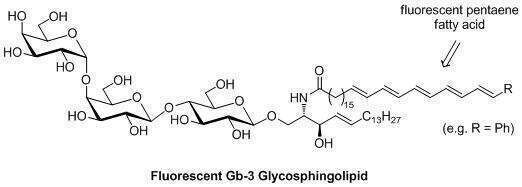The distinct modification of carbohydrates and glycolipids has become an important tool in chemical biology and medicinal chemistry.[1]By attaching fluorescent dyes to biomolecules their transport behavior and metabolism might be visualized. In any case it is highly important not to disturb the native structure to a major extent.
Modular syntheses leading to well-defined glycosphingolipids starting from monosaccharide building blocks, sphingosine and fatty acids are presented. The biophysical behavior of these tailor-made glycolipids in model membranes is investigated. Questions of raft formation[2]within the membrane depending on the kind of fatty acid (e.g.hydroxylated, saturated or unsaturated) will be discussed. In addition, the effect of carbohydrate-binding proteins on the reorganization of the membrane is elucidated.[3]Novel fluorescent fatty acids mimicking in terms of sterics their saturated counterparts were accessed by a Wittig-Horner/elimination strategy.[4]Attachment of these species to glycolipids make an optical visualization of the domains in the membrane by means of fluorescence microscopy possible.[3]

[1]Review:D. C. Koester, A. Holkenbrink, D. B. Werz,Synthesis2010, 3217-3242.
[2]K. Simons, E. Ikonen,Nature1997,387, 569-572.
[3] A. Ries, O. Schütte, A. Orth, L. Patalag, C. Steinem, D. B. Werz,manuscript in preparation.
[4] L. J. Patalag, D. B. Werz,J. Org. Chem.2012,77, 5297-5304.

